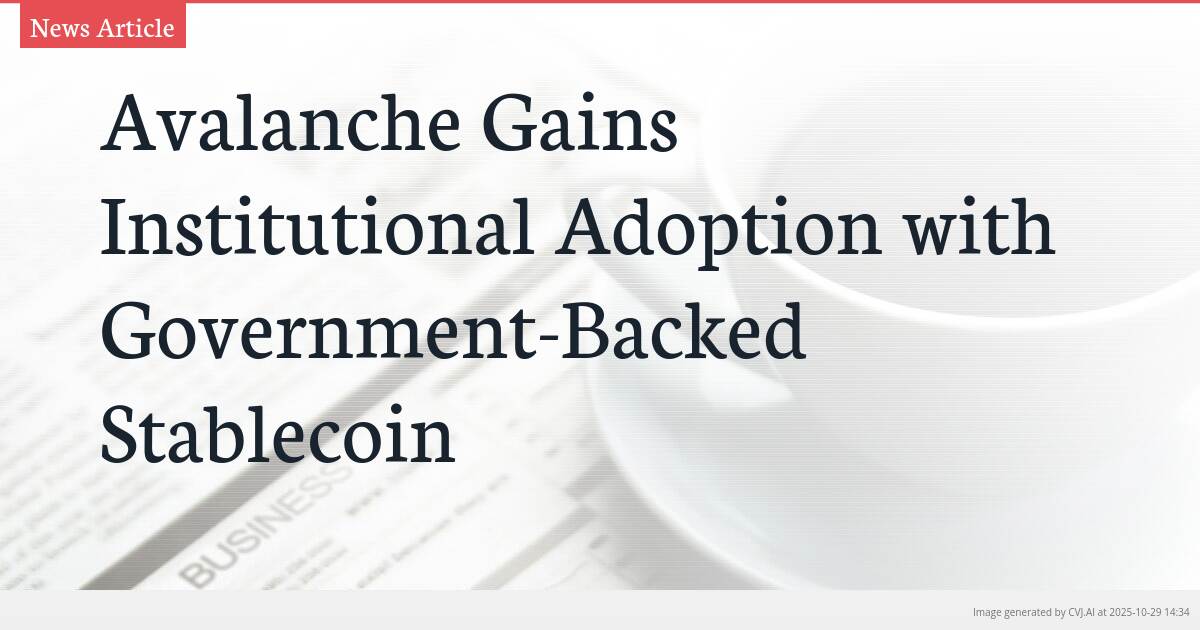This summary text is fully AI-generated and may therefore contain errors or be incomplete.
Introduction
Avalanche blockchain is emerging as a preferred platform for institutional capital tokenization and government integrations. Wyoming’s Stable Token Commission has launched the first government-backed stablecoin on Avalanche, marking a significant milestone in public sector blockchain adoption. This development signals growing institutional confidence in blockchain infrastructure despite market volatility.
Key Points
- Wyoming's Stable Token Commission issued the first government-backed stablecoin (FRNT) on Avalanche and six other blockchains
- FRNT stablecoin maintains 102% collateralization with US dollars and short-duration Treasury bills
- Avalanche is becoming a preferred blockchain for institutional tokenization despite its native token's price performance lagging historical highs
Institutional Capital Flows to Avalanche Blockchain
According to blockchain analytics firm Nansen, institutions are tokenizing hundreds of millions in capital on the Avalanche blockchain, transforming government and traditional finance integrations into onchain reality. This institutional movement represents a significant validation of blockchain technology’s potential beyond speculative cryptocurrency trading. The trend highlights how established financial entities are increasingly viewing blockchain infrastructure as a viable platform for real-world financial applications.
The growing institutional preference for Avalanche comes despite its native token AVAX continuing to trade far below its all-time high. This divergence between network adoption and token price performance suggests that institutions are evaluating blockchain platforms based on technical capabilities and regulatory compliance rather than short-term price movements. The sustained institutional interest indicates a maturing market where fundamental utility is becoming more important than speculative trading patterns.
Wyoming's Groundbreaking Government-Backed Stablecoin
During the past quarter, Wyoming’s Stable Token Commission issued the first government-backed stablecoin, the Frontier Stable Token (FRNT), on Avalanche and six other public blockchains. This landmark development represents one of the most significant government adoptions of blockchain technology to date. The multi-chain approach demonstrates how governments are strategically leveraging multiple blockchain networks to ensure broad accessibility and redundancy.
The FRNT stablecoin launched as a fully collateralized digital asset backed by US dollars and short-duration US Treasury bills with a mandated 102% reserve requirement. This conservative collateralization approach exceeds typical industry standards and reflects the government’s commitment to financial stability and risk management. The inclusion of short-duration Treasury bills in the reserve composition provides additional yield while maintaining high liquidity and minimal price volatility.
Wyoming’s strategic move positions the state as a leader in blockchain innovation within the United States regulatory landscape. The Stable Token Commission’s decision to include Avalanche among the launch platforms signals confidence in the network’s technical reliability and compliance capabilities. This government endorsement could pave the way for other states and federal agencies to explore similar blockchain implementations.
The Future of TradFi and Government Blockchain Integration
The successful deployment of FRNT on Avalanche demonstrates how blockchain technology is increasingly bridging the gap between traditional finance and digital assets. The stablecoin’s design, with its emphasis on regulatory compliance and robust collateralization, addresses many of the concerns that have previously limited institutional participation in the crypto space. This approach provides a template for how other government entities might structure their blockchain initiatives.
The growing institutional tokenization activity on Avalanche, combined with government stablecoin deployments, suggests that blockchain infrastructure is reaching a critical inflection point for mainstream financial adoption. As more traditional financial institutions and government bodies witness successful implementations like Wyoming’s FRNT, the momentum toward broader blockchain integration is likely to accelerate. This trend could fundamentally reshape how capital markets and government financial operations function in the coming years.
Despite the current disconnect between Avalanche’s institutional adoption and its token price, the network’s positioning as a preferred platform for government and TradFi integrations suggests long-term strategic value. As blockchain technology continues to mature and regulatory frameworks become clearer, platforms that have established credibility with institutional and government partners may be best positioned for sustained growth and development in the evolving digital asset landscape.
📎 Read the original article on cointelegraph.com

